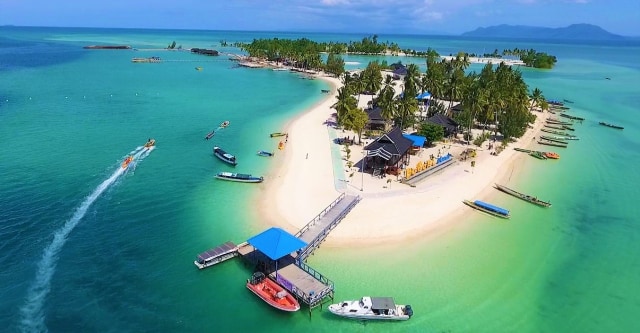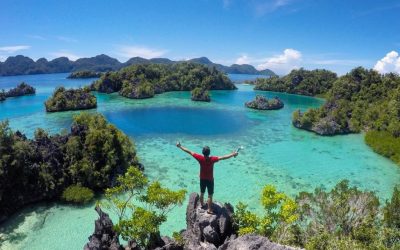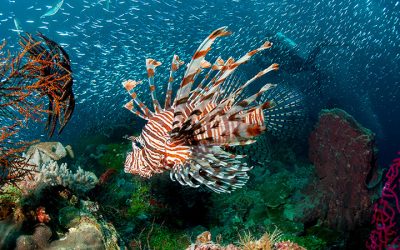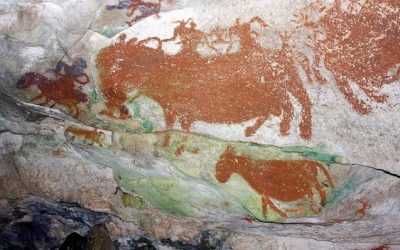Home / Batik Regions – Central Indonesia – Sulawesi Island – Southeast Sulawesi / Bajo Coastal Village in Bokori Island
Natural Destination
Experience the tropical nature!
Bajo Coastal Village in Bokori Island
Bokori Island (Photo: @Ilmah Surahmin)
Bajo Coastal Village in Bokori Island
Located not far from Kendari City, this small island is a-must-visit in Southeast Sulawesi. Here you could discover an authentic coastal village which has been inhabited by Bajo tribe for centuries. Visitors could rent speed boats for crossings to the island to enjoy the coastal scenery, beautiful coral reefs, white sand, and clean sea water. While maintaining its environmental authenticity, Bokori island has developed into a developing tourism site. It is a great alternative weekend getaway for those who want to enjoy coastal culinary experience with a low budget.
Natural Tourism Destination
Bajo Coastal Village in Bokori Island
Tourist Attractions in Southeast Sulawesi
Labengki Island – Giant Clam Marine Reserve
No one knows that the second biggest Kima giant clam (Tridacna gigas) with the size of 50 cm can be found in
Wakatobi UNESCO Biosphere Marine Reserve
Known as marine paradise, Wakatobi was designated as UNESCO marine biosphere in
Kobori Cave
According to history, the marvelous Megalithic Kobori Cave has existed since 4000 B.C.
Southeast Sulawesi
Batik Motifs
Pati-Pati Pinehiku
It symbolizes the hierarchy in society and the social status of the Mekongga
Wakatobi
It symbolizes the coastal beauty of the Wakatobi island and the symbol of Patra symbolizes
Ake Patra
Ake is related to the divinity and the composition of the universe. It is a symbol of
Discover
Indonesian
Batik
Motifs
Tampuk Manggis Sasirangan
The motif illustrates the philosophy of the mangosteen fruit, which is
Durian Pecah
Broken Durian motifs depict the foundation of faith. The second half signifies the mastery of
Sekomandi
Its philosophical meaning is the eternal union which refers to a saying “until death do us part”
Kaganga Tanah Rejang
If Batik Besurek combines Arabic calligraphy motifs, then the Kaganga batik takes
Kuda Kupang
Horses symbolize wealth. It contains noble values of virtuous characters that bring
Raja Ampat
Raja Ampat motif represents the marine life at Raja Ampat archipelago in
Bultiya
The word ‘Bultiya’ is an acronym of the three major tribes in North Kalimantan, namely
Merak Ngeram
The hatching peacock motif has a very deep meaning which refers to the sacrifice and
Pati-Pati Pinehiku
It symbolizes the hierarchy in society and the social status of the Mekongga
Dayak Kamang
Kamang motif is generally found in the Dayak tribe shield because it is believed to
Desa Na Tolu
The Desa Na Tolu characteristic pattern symbolizes the Batak philosophy of existence and
Insang Ikan
Insang refers to the gills of the fish. This is a typical pattern of Malay ethnic who inhabits
Besurek Rembulan
This batik illustrates praise for God who created the wonderful universe
Pattimura
Pattimura is the name of an Indonesian hero who fought against colonialism in
Gamolan
This motif illustrates Gamolan, a bamboo musical instrument of Lampung that is
Gentala Arasy
Built as high as 80 meters, the tower also highlights the historical side of
Lipaq Sabe
Lipaq Saqbe contains a simple geometric classical motif with various flower decorations. This textile is
Ukir Sentani
The Ukir motif is a batik motif that is inspired by various traditional Sentani wood carvings
Tubo Kelapa
Coconut tree is a symbol of a good character and strong mentality. It illustrates the more success a person, the more
Bekantan Pakis
This motif represents Pakis Haji (Polystichum setiferum), an endemic plant in
Tenun Bima
The motifs are adopted from Bima woven textile. This pattern has received a great
Angsa Duo
According to legend, the Angso duo batik motif is a pair of swans that are believed to have led Princess
Tanah Liek
The word “Tanah Liek” refers to clay in Minang language. It is also known as
Rumah Mamuju
the Batik motif illustrates the house of Mamuju King with the stairs, located on the left of the wooden stage house
Tifa Totobuang
The batik motifs illustrate Maluku’s traditional music instrument called
Tongkonan
Toraja’s traditional house is called Tongkonan. Tongkonan is a place for
Malinau Cultural Festival
You will witness a unique competition that might not be found other than in
Ake Patra
Ake is related to the divinity and the composition of the universe. It is a symbol of
Gonggong Beruntun
This motif illustrates that a person should maintain a positive attitude and
Lok Baintan Floating Market
As you can imagine, the most authentic thing is that you can buy things and even
Ikan tambal
The word “Ikan” refers to fish. The philosophical meaning of Ikan Tambal means is
Taiganja
Taiganja is a precious gold pendant that shows the social status of the Kaili family. It is
Kawung
The Kawung motif was created by Sultan Agung Hanyokrokusumo (1593 – 1645) as a symbolic gift for
Parang Rusak
Another meaning behind this motif is an unconquerable spirit, symbolized by
Leuit Sijimat
This motif reflects the daily activities of the Baduy tribe in Banten. The main ornaments of batik motif consist of:
Teguh Bersatu
This batik motif shows the strength of the people of Kupang. It also represents a sense of
Mahkota Siger
Siger is the crown of a noblewoman in ancient time. It is a symbol of femininity, strength, and
Gajah Way Kambas
The motif illustrates the Lampung’s natural reserve, the Way Kambas. it also symbolizes
Honai
The Honai is inspired by the traditional house of the Papuan community living in
Sandeq
Sandeq Boat is a symbol of the maritime importance of the West Sulawesi region. The greatness of
Wakatobi
It symbolizes the coastal beauty of the Wakatobi island and the symbol of Patra symbolizes
Bomba Mawar
This motif means sacred love for family, kingdom, and God; It also illustrates
Daun Sirih
This motif illustrates betel leaves that are used by Lombok communities as traditional
Pucuk Rebung Riau
Pucuk Rebung symbolizes heart determination in achieving goals, good luck, and
Sekar Jati
Sekar means flower and Jati refers to teak trees that symbolizes a strong mental character that
Awan Berarak
Awan Berarak is a combination of Dayak motifs and Malay patterns. The word ‘Awan Berarak’ means the
Pala Salawaku
This motif illustrates the unique weapons of the Maluku region, namely
Daun Lada Hitam
The black pepper motif represents the main commodity of Bangka Belitung
Cengkeh
The clove flower motif is the main commodity of the Tolitoli Regency. This motif represents
Tengkawang Ampiek
With its many advantages, the Dayaks use this leaf in ritual ceremonies. This plant is a symbol of
Gigi Haruan Lidi
The Gigi Haruan Lidi motif is taken from the name of the cork fish and is a symbol of
Karawo Mahkuta
Mahkuta refers to Gorontalo’s traditional crown. It represents noble characters of
Kain Cual
Cual textile tradition has existed since the 17th century. The word “Cual” refers to
Jumputan Bintang
The word Jumputan means the tie-dye technique, while the word “Bintang” refers to
Singayaksa
The Singayaksa motif comes from the name of a place where Sultan Hasanuddin used to
Manguni Minahasa
Manguni is identified as the symbol of the Minahasa people. Manguni is known as a
Pohon Hayat (Tree of Life)
The Batik motifs in Lampung are dominated by the acculturation of Buddhist and
Daun Simpor
This motif is inspired by the Simpor plant (Dillenia Suffruticosa) which is a typical
Biji Kopi
The coffee seeds motif illustrates the pride of local coffee specialities in
Burung Bidadari
Bidadari birds are endemic birds in Halmahera. This motif represents an
Bale Lumbu
This motif signifies the welfare of the ancient Sasak society. Bale also symbolizes the
Kerawang Tegak Aceh
The Vertical Upright (Kerawang Tegak) Motif symbolizes a person who has a strong
Jupri Kembang Teh
Kembang Teh illustrates the tendrils of tea plants that grow in the highlands of
La Galigo
La Galigo is a literary work of the Buginese Epic that has 300 thousand epic lines. It is considered even
Besurek Rafflesia
The term “Basurek” refers to a textile that contains letters or inscriptions
Tabir Tanjung
Tanjung flower is a type of Cherry tree flower, which is commonly found in
Srimanganti
The name of the Srimanganti motif is derived from Palace’s hallway that connects to
Kaharingan
The Kaharingan or ‘tree of life’ based on the Dayak tribes’ belief system. This tree symbolizes
Gumin Tambun
Based on Hindu mythology, this motif symbolizes lucks, abundant wealth, and
Dayak Taghol
Dayak Taghol has a distinctive style of four curved lines and small dots. This motif represents




